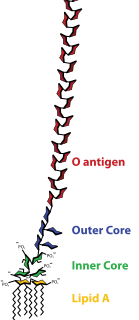
In bacteriology, gram-positive bacteria are bacteria that give a positive result in the Gram stain test, which is traditionally used to quickly classify bacteria into two broad categories according to their type of cell wall.

Gram-negative bacteria are bacteria that do not retain the crystal violet stain used in the Gram staining method of bacterial differentiation. They are characterized by their cell envelopes, which are composed of a thin peptidoglycan cell wall sandwiched between an inner cytoplasmic cell membrane and a bacterial outer membrane.

Lipopolysaccharides (LPS) are large molecules consisting of a lipid and a polysaccharide composed of O-antigen, outer core and inner core joined by a covalent bond; they are found in the outer membrane of Gram-negative bacteria. The term lipooligosaccharide ("LOS") is used to refer to a low-molecular-weight form of bacterial lipopolysaccharides.

Polymyxins are antibiotics. Polymyxins B and E are used in the treatment of Gram-negative bacterial infections. They work mostly by breaking up the bacterial cell membrane. They are part of a broader class of molecules called nonribosomal peptides.

The bacterial capsule is a large structure common to many bacteria. It is a polysaccharide layer that lies outside the cell envelope, and is thus deemed part of the outer envelope of a bacterial cell. It is a well-organized layer, not easily washed off, and it can be the cause of various diseases.
In prokaryote nomenclature, Candidatus is used to name prokaryotic phyla that are well characterized but yet-uncultured. Contemporary sequencing approaches, such as 16S sequencing or metagenomics, provide much information about the analyzed organisms and thus allow to identify and characterize individual species. However, the majority of prokaryotic species remain uncultivable and hence inaccessible for further characterization in in vitro study. The recent discoveries of a multitude of candidate taxa has led to candidate phyla radiation expanding the tree of life through the new insights in bacterial diversity.
The International Code of Nomenclature of Prokaryotes (ICNP) formerly the International Code of Nomenclature of Bacteria (ICNB) or Bacteriological Code (BC) governs the scientific names for Bacteria and Archaea. It denotes the rules for naming taxa of bacteria, according to their relative rank. As such it is one of the nomenclature codes of biology.

Bacterial phyla constitute the major lineages of the domain Bacteria. While the exact definition of a bacterial phylum is debated, a popular definition is that a bacterial phylum is a monophyletic lineage of bacteria whose 16S rRNA genes share a pairwise sequence identity of ~75% or less with those of the members of other bacterial phyla.
Bacterial taxonomy is the taxonomy, i.e. the rank-based classification, of bacteria.
Gluconacetobacter sacchari is a species of acetic acid bacteria first isolated from the leaf sheath of sugar cane and from the pink sugar-cane mealy bug on sugar cane growing in Queensland and northern New South Wales. The type strain of this species is strain SRI 1794T. It is notable for its production of bacterial cellulose and for being an endophyte in sugar cane.
Azoarcus tolulyticus is a species of bacteria. It is a nitrogen-fixing bacteria. It is notable for degrading toluene. Tol-4 is its type strain.
Shewanella gelidimarina is a species of bacteria, notable for being an Antarctic species with the ability to produce eicosapentaenoic acid. It grows anaerobically by dissimilatory Fe (III) reduction. Its cells are motile and rod shaped. ACAM 456 is its type strain.
Psychrobacter jeotgali is a species of bacteria named after jeotgal, a traditional Korean fermented seafood, where it was first isolated. It is a Gram-negative, non-motile, non-spore-forming, and moderately halophilic coccus. The type strain is YKJ-103T.
Psychrobacter cryohalolentis is a Gram-negative, nonmotile species of bacteria. It was first isolated from Siberian permafrost. Its type strain is K5T.
Desulfuromonas chloroethenica is a gram-negative metal-reducing proteobacterium. It uses tetrachloroethylene and trichloroethylene as electron acceptors.
Methylocella tundrae is a species of bacterium. It is notable for oxidising methane. Its cells are aerobic, Gram-negative, non-motile, dinitrogen-fixing rods. Strain T4T is the type strain.
Virgibacillus arcticus is a moderately halophilic, endospore-forming bacterium originally isolated from permafrost in the Canadian high Arctic. Its type strain is Hal1T.
Psychrobacter is a genus of Gram-negative, osmotolerant, oxidase-positive, psychrophilic or psychrotolerant, aerobic bacteria which belong to the family Moraxellaceae and the class Gammaproteobacteria. The shape is typically cocci or coccobacilli. Some of those bacteria were isolated from humans and can cause humans infections such as endocarditis and peritonitis. This genus of bacteria is able to grow at temperatures between −10 and 42 °C. Rudi Rossau found through DNA-rRNA hybridization analysis that Psychrobacter belongs to the Moraxellaceae. The first species was described by Juni and Heym. Psychrobacter occur in wide range of moist, cold saline habitats, but they also occur in warm and slightly saline habitats.
Psychrobacter salsus is a Gram-negative, strictly aerobic bacterium of the genus Psychrobacter, which was isolated from the fast ice in the middle of Geologie Archipelago in Adelie Land in Antarctica.
Methanocalculus halotolerans is a species of archaeon, the type species of its genus. It is an irregular coccoid hydrogenotrophic methanogen. Its type strain is SEBR 4845T.





